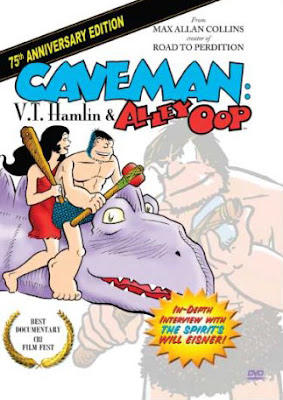The documentary "Caveman: V.T. Hamlin & Alley Oop" is—among all of the artist documentaries I've watched and despite its best efforts—the weakest. The excessive music, especially at the beginning, almost convinced me to stop watching. The biggest drawback is that the artist himself is not interviewed. Hamlin passed away in 1993 and the DVD was released in 2008. Without his presence, the next best option would have been Hamlin's writings, assuming he had any, which would have given insight into his methods and thinking. Another alternative would have been to interview his contemporaries or people he worked with or associated with in his early years.
Since these documentary staples are absent, the primary interviews are with Hamlin's daughter, Teddy DeWalt; the successor with whom Hamlin worked, David Graue; and Graue's successor, Jack Bender. Their recollections are vivid but limited in comparison to what could have been.
Surprisingly, the best part of this DVD is one of the extras, Will Eisner's 2001 Comic Con interview. He talked about both Alley Oop and sequential art in general.
Despite the film's shortcomings, I did learn more about the Alley Oop strip than I otherwise would have known. It is possible, moreover, to pull some kernel of truth or inspiration even from a mediocre documentary. Here are 13 things to think about:
1. Teddy DeWalt re: Hamlin: his standard comment to most young people was, "If a day came when you had to eat or draw, but you could only choose one and you chose to eat, you probably wouldn't have the drive to go on drawing for a lifetime's work."
2. DeWalt re: Hamlin's retirement: he woke up to real life. He had been before—by his own admission—entirely immersed in a fantasy world, in the world of Alley Oop and all those cartoon characters. They were more real to him than his family was or the people around him. He lived them, he ate with them, they talked to him, he dreamed about them.
3. Will Eisner: comics is a literary art form capable of dealing with subject matter deeper than gags and superheroes.
4. To Eisner's memory, "Alley Oop was the first thinking strip, others were gags and jokes. It went beyond Gertie the Dinosaur; it brought us into a prehistoric world. It showed his research, [research] didn't appear prior to that in other strips.
5. Eisner's influences were Popeye, Terry and the Pirates and Krazy Kat. They all showed physical energy without really physically moving. Incredible humor predicated on misuse of the English language.
6. Re: The Spirit—humor's more universal in understanding than a straight, severely told story.
7. "Costumed characters" was the original name for superheroes. The humor came from the action. Eisner was constantly looking for believability because he was telling slice-of-life stories. Most of his ideas came from a Monday morning newspaper story.
8. "Humor is exaggeration. It depends heavily on the reader's perspective."
9. "My ambition was to write a short story [7 page Spirit comics] every day."
10. His experimentation was a result of and the reward for creating novelty. He was in constant pursuit of reader attention.
11. "The early superheroes were done by interchangeable artists over time. The publishers owned everything; the creators had no equity in their work. The daily strip cartoonists hand an identity. Everyone knew who drew what. The name associated with the strip helped sell it to papers. Daily strips became a daily connection, a part of one's life."
12. "You can't grow a strip once it's sold to the paper. It has to continue as it was from the beginning." [Eisner tired of this and gave up on a daily The Spirit 4-panel strip.]
13. "I saw Alley Oop as a young man as an Anderson [Hans Christian Anderson?] story. Continuing children's story; something friendly about that. It wasn't going anywhere; didn't expect it to reach a climax at any point. Just wanted it to be there and see what Alley Oop would do next. It wasn't like the typical adventure strip that reached a climax, where the villain was going to be caught and all was going to be well. Alley Oop was like visiting an ongoing world. Knew he would get out of his dangers and the reader was amused at how he did it. Something neverending bout that strip that didn't appear in others."

